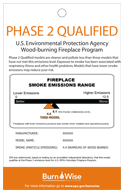Choosing the Right Fireplace or Fireplace Retrofit Device
Types of Fireplaces
- Traditional masonry fireplaces that are typically built of brick or stone and are constructed on site by a mason
- Low mass fireplaces that are engineered and pre-fabricated in a manufacturing facility prior to installation
Low mass fireplaces are a lower-cost option widely used in new home construction in the United States. Most fireplaces, whether masonry or low mass, are not used as a primary source of heat- they function primarily for ambiance and secondary heating. In fact, most traditional open fireplaces lose over 90 percent of the fire's heat out the chimney, and much of the heated air in the room goes with it.
Fireplaces should not be confused with fireplace inserts, which are wood stoves converted to fit in existing fireplace openings.
Fireplace Retrofits
EPA-qualified Fireplaces and Fireplace Retrofit Devices
EPA's Voluntary Fireplace Program for manufacturers of wood-burning fireplaces and fireplace retrofit devices encourages the manufacture and sale of cleaner units. EPA does not promote the sale of wood-burning fireplaces over other devices; however EPA does encourage those who buy a fireplace to buy the cleanest model.

